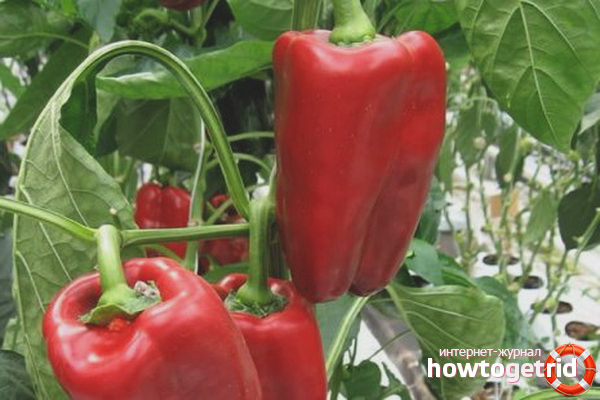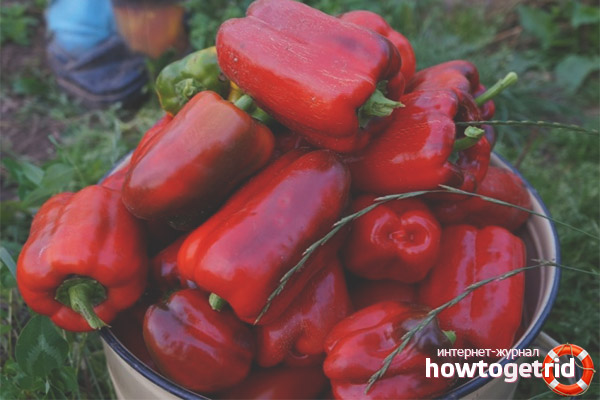The content of the article
Large-fruited bell peppers are grown mainly in seedlings. Sow seeds in early March. This should not be done before, because due to a lack of light the seedlings will turn out to be weak, non-viable.
In the fruits of bell pepper Krastny bull accumulates a large number of vitamins of group A, namely, carotenoids, xanthophyll, lycopene. In the seed chambers of pepper a small amount of seeds ripens. The plant has a high yield, in the summer from one bush you can get up to 16 fruits.
You can get full-fledged large fruits of bell pepper Red bull in your garden by growing previously strong seedlings in cups or pots.
Growing seedlings
Buy seeds in specialized stores, from trusted, reliable suppliers. Soil use fertile, structured, loose. Before sowing seeds, check for germination. Seed treatment with fungicides and growth stimulants is recommended.
The first 10 days after the start of growing pepper, the temperature should not fall below 22 degrees.
The first problem that beginner gardeners may encounter when growing seedlings on the windowsill is a black leg disease. This is a fungal disease that occurs with increased humidity and lack of ventilation, when droplets of condensate flow down the surface of the container. To avoid this unpleasant disease, regularly ventilate the seedlings, do not allow waterlogging, do drainage in pots and cups for seedlings.
Peat tablets are also used to grow pepper planting material. Seedlings in them root painlessly, intensively add to growth after planting in open ground or a greenhouse.
Light when growing seedlings at home is as important as stable temperature. Dose seedlings for two hours every day in the morning and in the evening with special lamps.
When three true leaves appear, the seedlings dive into separate containers. If this is not done, then the plants will not have time to form a powerful fibrous root system. Do not forget that pepper does not tolerate transplantation; its roots grow much more slowly than the roots, for example, of tomatoes. A properly grown potted seedling forms a healthy and strong root system, plants take root well, and tolerate transplantation.
14 days after the pick, the plants are fed with urea or ammonium nitrate. Pepper seedlings grow well on window sills, if the windows are located on the south side of the house.
Seedlings of bell pepper does not tolerate drafts, lowering temperatures to 13 degrees, direct sunlight. In order to protect the plants located on the windowsill, protective screens are used from the bright rays of the sun.
Landing or greenhouses
Seedlings aged 55-60 days can be planted in the ground. Bell pepper can be planted in open ground after warming the soil. As a rule, they begin to plant culture in the last days of May.
Do not transfer plants to open ground until the threat of return frosts has passed. Pepper is a heat-loving plant that does not tolerate a drop in air temperature to 12-13 degrees. Plants that have been exposed to low positive temperatures stop growing, become oppressed, and yield a meager crop.
Compost, rotted manure is introduced into the planting holes, the soil is abundantly watered for good adhesion of roots to lumps of soil. If the seedlings have grown, there is a way out of this situation. The stem is laid in the soil, having dug a ditch at the same time, after 2 weeks it will give additional roots. When growing pepper in a greenhouse, you need to install an earthen thermometer.
When growing bell pepper in regions with a cool climate, where there is a cloudy, rainy summer, the construction of film shelters is recommended. Watering is carried out with warm water.
The first top dressing in open ground is performed 10 days after transplanting.
Pepper likes places protected from the wind, if the wind constantly blows on your site, do not expect a good harvest from this crop. The only way out is to build a protective structure from the wind.
Care
Sweet pepper responds well to top dressing with organic fertilizers. Regular watering is also important. Bushes are watered strictly under the root or in furrows, holes. In no case should the drying of the topsoil be allowed.
For growing red bull pepper, a well-warmed place without wind, on which there is practically no shadow, is suitable.
The retention of moisture in the soil is facilitated by the mulching procedure. As mulch, straw, mowed grass, hay or sawdust are used. In the soil, under the layer of mulch, earthworms, beneficial insects actively develop, the soil is saturated with air. After watering, the soil needs to be loosened, giving the roots oxygen.
Pepper grown using mulching, loosening the soil gives a stable high yield, while the fruits ripen larger.
A temperature above +35 degrees is harmful to the pollen of bell pepper, it simply becomes sterile, the flowers cease to be pollinated and an ovary does not form.
During flowering and ovary formation, it is not recommended to use a large amount of chemicals; it is better to feed pepper with folk remedies. Use a milk solution with iodine: 1 liter of skim milk, 20 drops of alcohol tincture of iodine in a bucket of water.
During the flowering period, be sure to remove the stepsons so that nutrients are not taken from the bush. Spray the plants with a zircon biostimulator to produce a plentiful crop.
Pasynkovka is an important technique that allows you to increase the productivity of pepper. If you do not remove the stepsons, then the forces of the plant will go to the formation of green mass, not fruits.
Watering and feeding
In the midst of summer, in hot, dry weather, large-fruited peppers are watered daily, mainly in the evening. Watering depth should be at least 30 cm. Peppers are watered in the evening or early in the morning. With such irrigation, plants are more able to absorb beneficial minerals and moisture.
Do not water the plants on a leaf; it is best to arrange drip irrigation or irrigation into furrows. After watering, weed growth is activated, they must be removed in a timely manner and the soil must be loosened without fail. Feeding is carried out with a dilute mullein solution.
You can feed the bushes with herbal infusion. It is prepared from mowed grass, nettles, garden weeds. Plant materials are laid in a barrel, poured with water and left to roam for 2-3 weeks. Fermented infusion is filtered, diluted with water and watered pepper.
Fruits from the bush must be removed in a state of technical ripeness. Subject to the rules of growing pepper, Red bull will delight you with delicious large fruits.
Video: red bull peppers and orange miracle












Submit